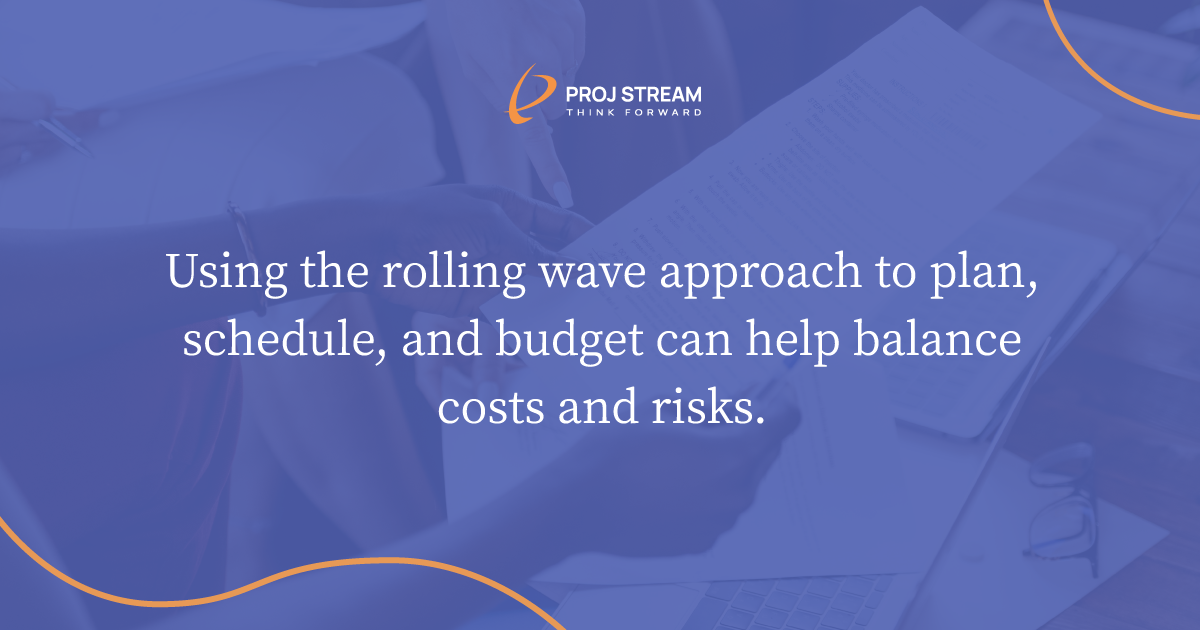Rolling wave planning is an incremental planning approach where near term work effort is planned in detail and future work effort is planned at a higher level until more is known about the work scope requirements. This process of progressive elaboration can be an asset when creating proposals for long-term efforts with many unknowns.
If you’ve ever planned a vacation trip, you’ve probably done some rolling wave planning. You know where you’re going (the end result) and you have high level expectations (the plan) of how to get there. You know generally what it will cost (the budget) and have a good idea of what the process will be (the assumptions). As you travel, you’ll be planning in greater detail to the part that’s coming right up –where you’ll have dinner, how you’ll get to your hotel, what activities you’ll do in that area. You’ll project what will happen on the next stage and adjust based on the reality of the current experience. For example, your budget may be affected by a free hotel stay or the timeline may be affected by a delayed flight, which may affect the next phases of the vacation project. It’s a roadmap allowing a team to adapt and make changes to assure the best possible outcome.

What Is Rolling Wave Planning?
Sometimes called continuous planning or block planning, rolling wave planning is so named because the project planning comes in waves. Is a useful technique for longer duration projects where the statement of work (SOW) is likely to change.
It has some similarities to the scrum framework used in agile software development, which also uses a time block-based approach and incremental project development. However, rolling wave planning better supports the development of hardware projects, which typically have a more defined order of operations. It is dependent on ongoing clear communication, the creation of highly detailed work planning packages, and careful management of tasks.
As the project progresses and more becomes known about the future work effort, the higher-level planning packages are converted to detailed plans as soon as possible, maintaining a continuous planning horizon for near term work.
Summary level planning packages (SLPPs) within the work breakdown structure (WBS) or control account planning packages are included as activities in the integrated master schedule (IMS) with durations and budget allocation for the likely resource requirements. This complete set of planning and budget data are necessary to establish the performance measurement baseline (PMB) for the entire scope of work.
The goal is to maintain that “just right” balance of sufficient detailed planning for work effort coming up to proactively manage the project.
What Are the Benefits of Rolling Wave Planning?
Using the rolling wave approach to plan, schedule and budget can help balance costs and risks. Projects in which there are many unknowns can present a plan that’s realistic and focused on the project’s end result. Trying to plan for everything can cause important details to be overlooked and rolling wave planning provides the right level of focus at the right time. And it allows productive activity to happen without waiting for detailed plans that would likely have changed when new risks were identified.
When properly used, this realistic way to manage long-term projects helps to:
- Reduce the time required to develop the schedule and budget plan for future work effort in situations where you don’t yet have the necessary information to define the detailed tasks.
- Ensure you have allocated the necessary budget for the future work scope and scheduled the work in the IMS. Budget allocations for future work effort should be specific to the work for which it is intended, time phased in alignment with the schedule activities, periodically reviewed for validity, and not used to perform other work scope. The intent is to prevent the situations where project personnel “borrow” the budget allocated for future work to complete current work effort.
- Reduce the volume of baseline change requests. When you don’t have the necessary information to define future detailed tasks, why create the detailed tasks in the first place when you know things will change multiple times? It is better to define and maintain a control account planning package or a summary level planning package until you can define the detailed tasks. Then you can convert the control account planning package to one or more work packages with an assigned earned value technique. Or, you convert a SLPP to one or more control accounts with subordinate work packages and planning packages.
What Is Required to Implement Rolling Wave Planning?
Implementing rolling wave planning does require a level of project control discipline. For example:
- A planning package must be converted to one or more work packages (scope, schedule, and budget) with an assigned earned value technique before work begins. Your rolling wave planning process should strive to ensure work is detail planned as soon as it is practical depending on the nature of the work.
- You will need a means to reconcile your detail planning changes at the control account level to previous dates and values. There are many considerations at this stage, including:
- What was the impact of converting a planning package to a work package?
- Did the work scope, period of performance, or budget allocation for the control account stay the same because of the detailed planning? Or, did it change?
- If it changed, did the change impact other work packages or other control accounts?
- If you converted a summary level planning package to one or more control accounts, was the budget allocation for the control accounts the same or different? Or, did only a portion of the summary level planning package get converted to a control account?
You will need to reconcile the budget values to the project level contract budget base, distributed budget, and undistributed budget when applicable.
- You will need similar basis of estimate (BOE) rationale for this detail planning as you did during the proposal phase. The basis of estimate details are necessary to substantiate the work package schedule activities, duration, resource requirements, and budget allocation. The BOE details can also help the control account manager (CAM) select an appropriate earned value technique for a work package to measure performance.
Implementing Rolling Wave Planning with ProjStream’s End-to-End Solution
ProjStream’s tools can help you implement rolling wave planning easily.
Using integrated tools like BOEMax basis of estimate software and MaxTeam earned value management tools will simplify and support your project control requirements at the same time.
1. Convert a planning package into one or more work packages in BOEMax bidding software.
The first step is to work through the process of converting a planning package into one or more work packages in BOEMax bidding software. This can be an iterative planning process of updating the current schedule activities and resource assignments to detail plan the work packages. Using the BOEMax schedule integration utilities, you can produce the work package time phased budget details from the resource loaded activities. As part of the process, the BOE rationale is documented in BOEMax.
This addresses two data traceability requirements:
- The resource loaded schedule activities and time phased budget details align.
- You can substantiate how you determined the tasks, duration, resources, and budget allocation for the work package scope of work.
2. Initiate the built-in workflow process in BOEMax estimate software and MaxTeam earned value analysis software
The next step is to initiate the built-in workflow process in BOEMax estimate software and MaxTeam earned value analysis software that automatically produces data-backed documentation for you and ensures changes are implemented as approved. The changes you made in BOEMax provide the detailed source data for the baseline change request (BCR).
Once the BCR is approved, the changes are rolled in the control account work authorization with the approved changes merged into our earned value management system. This makes it very easy to:
- Demonstrate historical traceability for the entire duration of the project. Each BOE, BCR, and work authorization form reflects the source data in BOEMax and MaxTeam so you know what changed when.
- Reconcile the current budget values to previous budget values for each rolling wave planning cycle. The change log automatically records each project level and control account debit and credit transaction with a summary row generated at the end of each reporting period.
If you are interested in learning more about rolling wave best practices, visit the NDIA Integrated Program Management Division (IPMD) website where you can download the Planning & Scheduling Excellence Guide (PASEG).
Looking to improve how you implement rolling wave planning into your project control process? Call or schedule a demo of BOEMax proposal writing software and MaxTeam earned value management software today.
Updated January 17, 2022



